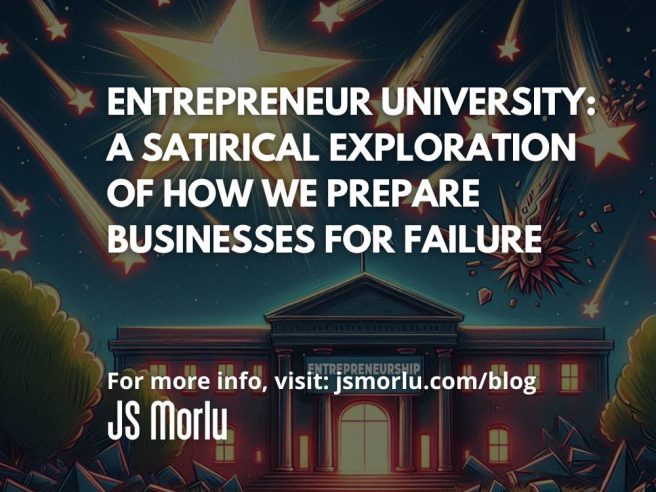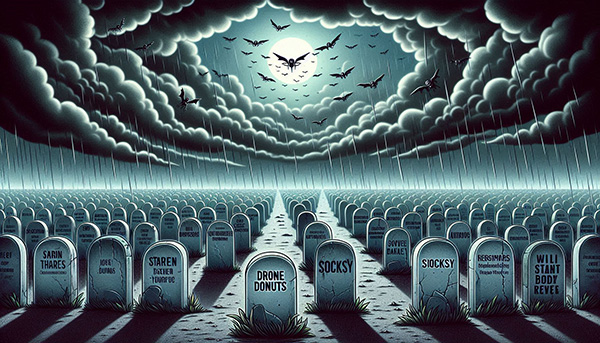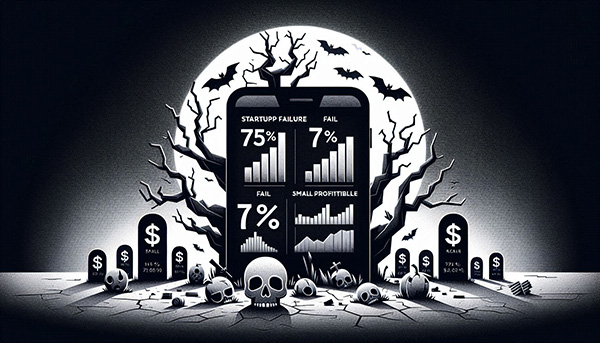By: John S. Morlu II, CPA
Entrepreneurship: The New Rock Star Career and the Universally Disastrous Paradox
In a world where entrepreneurship is the new rock star career, everyone from your local barista to your dog-walking neighbor seems to be harboring billion-dollar startup dreams. The allure of creating the next big thing—whether it’s a groundbreaking app, a revolutionary product, or an avant-garde service—has gripped our collective imagination. And who can blame them? The image of a young visionary triumphantly ringing the Nasdaq bell, surrounded by a cheering crowd of investors and admirers, is as intoxicating as it is elusive.
Enter Entrepreneur University (EU), a mythical institution where the curriculum is crafted with the precision of a Swiss watchmaker and the ambition of an over-caffeinated visionary. Here, students embark on a four-year odyssey designed not just to impart knowledge, but to arm them with every conceivable tool and strategy to conquer the entrepreneurial world. The education is as thorough as it is intense—students learn everything from market analysis to investor pitching, from product development to customer acquisition. They’re equipped with slick business plans, polished pitches, and an array of buzzwords that could make even a seasoned marketer blush.
But here’s the catch: Despite the rigorous training and seemingly foolproof methodologies, EU graduates often face a harsh reality. The more they know, the more they realize how little they truly understand about the wild and unpredictable world of startups. The paradox is grandiose—armed to the teeth with the latest entrepreneurial theories and strategies, graduates are paradoxically more likely to stumble into the abyss of failure. As it turns out, the road to startup success is as fraught with peril as a high-stakes game of roulette, and the house odds are not in your favor.
The Allure of the Entrepreneurial Dream
The world has become infatuated with the entrepreneurial dream. It’s everywhere: in inspiring TED Talks, in glossy magazine covers, and in the constant stream of success stories that flood our social media feeds. The idea of disrupting an industry, scaling a startup to a unicorn valuation, or simply being your own boss has become the epitome of success. It’s no wonder that universities worldwide are scrambling to cash in on this trend by offering a smorgasbord of entrepreneurial programs.
Take Harvard Business School’s Arthur Rock Center for Entrepreneurship, for example. Here, students are taught the delicate art of pitching to venture capitalists and are groomed to become the next wave of industry leaders. The curriculum includes high-stakes simulations, networking galas, and classes on creating business models that sound so futuristic they might as well come from a sci-fi novel. Graduates leave the hallowed halls of Harvard with glossy investor-ready pitches and high-tech business cards made from recycled aluminum, convinced that they are poised to take on the world.
Meanwhile, over at MIT’s Legatum Center for Development and Entrepreneurship, the focus is on high-tech innovation. MIT students are known for their groundbreaking work in robotics, artificial intelligence, and biomedical engineering. They tinker with algorithms, design prototypes, and conduct cutting-edge research, all with the aim of creating the next big technological breakthrough. Yet, despite the vast resources and world-class mentorship available, MIT graduates are not immune to the brutal reality of startup failures. The university’s impressive list of successful alumni doesn’t include the dozens of startups that went belly-up before they even had a chance to make headlines.
Stanford’s Entrepreneurial Gold Rush
Stanford University, located in the heart of Silicon Valley, is another prestigious institution where entrepreneurship is celebrated like a national holiday. The university’s Center for Entrepreneurial Studies is a beacon for ambitious students seeking to make their mark on the world. Stanford’s proximity to Silicon Valley means students have unparalleled access to top-tier investors, cutting-edge technology, and a vibrant entrepreneurial ecosystem. But here’s the kicker—despite the golden opportunity, the statistics for success are still grim.
At Stanford, students like Emily Venturebucks are encouraged to think big. Emily’s startup, MunchQuake, aimed to deliver snacks during minor earthquakes—a novel idea, to say the least. While the concept had its charm and even attracted a fair bit of initial interest, it ultimately faltered. Yet Emily’s story is not unique. For every Stanford graduate who goes on to create a billion-dollar company, there are countless others whose ventures crumble under the weight of unrealistic expectations and market realities.
The Irony of Excessive Preparation
The irony of these prestigious entrepreneurial programs is a comedic masterpiece in its own right. Despite having access to unparalleled resources, exclusive networks, and world-renowned accelerators, graduates often emerge with a sense of grandiosity that rivals a Hollywood blockbuster—only to face a reality check more crushing than an unexpected plot twist. It’s as if the universe has a twisted sense of humor, meticulously crafting these programs to ensure that their graduates experience the most dramatic faceplants imaginable.
The Grand Stage of Pitch Perfect
Take Entrepreneur University’s infamous Pitch Perfect course, for example. This course is designed to turn students into the Shakespearean thespians of investor pitches. Participants spend hours perfecting their storytelling techniques, crafting slides that rival the visuals of a Pixar movie, and rehearsing their pitches until they can recite them in their sleep. They are taught to weave their narratives with the precision of a surgeon and the charisma of a rock star. The final product is a pitch so polished that it could easily win an Oscar for Best Original Presentation.
Yet, despite their dazzling presentations and elevator pitches that could convince even the most skeptical investor to open their wallet, many graduates find themselves face-to-face with the cold, hard reality of the market. It’s almost as if the moment they step outside the hallowed halls of Entrepreneur University, their pitch-perfect personas crumble faster than a poorly constructed soufflé. The irony is as thick as a late-night infomercial: after years of intense preparation and a virtual parade of accolades, they are often no better equipped to handle real-world challenges than they were before they embarked on their entrepreneurial odyssey.
The Pomp and Circumstance of Perfection
This paradox is further illustrated by the experience of Brad McFailure, an Entrepreneur University alumnus who took the Pitch Perfect course to heart. Brad’s final presentation was nothing short of a Broadway spectacle. With a PowerPoint presentation that could make Steve Jobs weep, Brad pitched ShovelShare—a peer-to-peer shovel rental service—with the kind of flair that could sell sand in the desert. Unfortunately, Brad’s reality check came when he discovered that, while his pitch could dazzle a room full of venture capitalists, it was not quite as effective in a market that had never really considered the need for on-demand shovels.
The Misadventures of Over-Preparation
At prestigious institutions like Harvard Business School and Stanford, the tale is much the same. At Harvard’s Arthur Rock Center for Entrepreneurship, students are schooled in the arts of growth mindset, pivoting, and resilience, crafting startups with the ambition of transforming mundane tasks like grocery shopping or dog-walking into high-tech marvels. Despite having the resources and network to launch revolutionary ventures, many of these students face the same disillusionment as their counterparts at Entrepreneur University.
Take Emma Trendchaser, a proud Stanford graduate who launched Socksy, a blockchain-enabled sock-matching service. Emma’s pitch was the stuff of legends—complete with a slick demo video and a prototype that showcased socks scanning themselves into a blockchain ledger. Yet, despite the razzle-dazzle and blockchain bluster, Socksy became a cautionary tale rather than a commercial triumph. Emma’s grand vision collided head-on with the stark reality that most people are quite content with a simple laundry basket.
The Dilemma of Over-Sophistication and the Role of Investors
The irony of over-preparation extends beyond the hallowed halls of prestigious entrepreneurial programs and into the world of investment, where the stakes are just as high and the failures often just as dramatic. The more sophisticated the training and the grander the pitches, the more spectacular the falls when reality doesn’t align with expectations. This paradox not only sets up entrepreneurs for a public faceplant but also leaves investors grappling with the fallout.
At Entrepreneur University (EU), students undergo an exhaustive curriculum designed to prepare them for every conceivable aspect of the entrepreneurial journey. The Pitch Perfect course, for instance, coaches students in the fine art of delivering investor pitches with Broadway-level finesse. They learn to craft compelling narratives, create stunning presentations, and articulate their value propositions with unmatched polish. Yet, despite this meticulous preparation, many graduates find themselves struggling with real-world challenges such as market competition, cash flow issues, and unforeseen obstacles. The irony is palpable: after years of preparation, they are often no better equipped to handle these challenges than when they started.
This paradox is mirrored in the investor world, epitomized by fictional figures like Stewart Risky, founder of Vulture Ventures. Stewart’s investment philosophy is to fund every glittering idea that crosses his path, from Sustainify—a company that turned non-recyclable waste into artisanal handbags—to Barkr, a social media platform exclusively for dogs. Despite a track record of over 100 failed investments, Stewart remains a sought-after figure in entrepreneurial circles, celebrated for his boundless optimism about the next big flop.
Stewart’s experience underscores a crucial point: while preparation and presentation are important, they are not foolproof guarantees of success. The polished pitches and high-tech tools often fall short when faced with the unpredictable nature of entrepreneurship. The ventures Stewart backs, despite their impressive pitches, frequently fail to translate into viable businesses. This highlights the inherent danger in overestimating the impact of a well-crafted presentation and the disconnect between preparation and actual market performance.
In the startup graveyard, where ambitious ventures often meet their end, each failed business adds to the long list of cautionary tales. From DroneDonuts, which crashed into a confectionary catastrophe, to Socksy, a blockchain-enabled sock-matching service that never took off, these failed startups underscore a fundamental truth: no amount of preparation can fully counter the unpredictable realities of the entrepreneurial landscape.
The comedic tragedy of excessive preparation is that it sets the stage for a spectacular public faceplant. The grandiose promises, flashy presentations, and sophisticated training often become meaningless when confronted with real-world challenges. The more you know, the more you realize how much you don’t know, proving that sometimes, the real world has a way of humbling even the most prepared individuals.
In the end, the role of investors and the startup graveyard remind us that while mastering the art of the pitch and acquiring an arsenal of high-tech tools are valuable, they are no substitutes for adaptability, resilience, and a healthy dose of humility. The journey of entrepreneurship, with its highs and lows, serves as a humorous yet poignant reminder that success is never guaranteed, no matter how sophisticated the preparation.
The Inescapable Reality
The entrepreneurial landscape is a paradox of grand proportions. Despite the extensive training, sophisticated tools, and vast resources provided by prestigious institutions like Harvard, MIT, and Stanford, the odds of startup success remain grim. The statistics are unforgiving: 75% of businesses fail within the first five years, only 7% ever reach $1 million in annual revenue, and fewer still achieve profitability.
The reality is that entrepreneurship is as unpredictable as it is glamorous. While universities and programs offer invaluable resources and support, they cannot guarantee success. The entrepreneurial journey is fraught with risk, and even the best-prepared individuals can fall victim to market forces, unforeseen challenges, and plain old bad luck.
In the end, the story of entrepreneurship is not just about success; it’s also about resilience, adaptation, and the courage to continue despite the odds. The graduates of Entrepreneur University, Harvard, MIT, and Stanford may face a higher likelihood of failure, but they also carry with them the invaluable lessons learned from their experiences. And while the statistics may be daunting, the spirit of entrepreneurship endures, driven by the hope that, against all odds, the next big idea might just be around the corner.
The Curriculum: Preparing You to Beat the Odds (Sort of)
At Entrepreneur University, students are trained in every aspect of the entrepreneurial journey, from ideation to liquidation. Entrepreneurship 101: How to Fail Confidently is the flagship course led by Professor Ivan Bankruptski, a three-time failed startup founder turned academic. “You’re 75% more likely to fail than to succeed,” he begins each class. “But that’s okay, because failing is trendy now. After all, how will you land a podcast deal if you haven’t failed forward?”
But EU isn’t the only place teaching the fine art of failure with a smile. Over at Harvard Business School’s Arthur Rock Center for Entrepreneurship, they might phrase it a little differently—focusing on growth mindset, pivoting, and resilience. Harvard students craft startups in their garages, convinced that their next app will revolutionize the post-it note industry or the way we communicate with our houseplants. Harvard is proud of its history of nurturing entrepreneurial superstars, like Mark Zuckerberg, who dropped out to turn Facebook into a global behemoth. Still, for every Zuck, there are hundreds of students who come out armed with investor decks, a Harvard stamp, and the same statistics: 75% of businesses will fail within five years.
Module 1: Ideation – Where Bad Ideas Come to Flourish
At Entrepreneur University, Ideation is where dreams are made and then immediately questioned by VCs in turtlenecks. The mantra here is that every idea is valid, no matter how absurd. Student Brad McFailure presents ShovelShare, a peer-to-peer shovel rental platform for people who find themselves suddenly needing a shovel. “You never know when you’ll need to dig a hole!” Brad insists.
Meanwhile, over at Stanford’s Center for Entrepreneurial Studies, students are developing “world-changing” ideas while mingling with Silicon Valley royalty. Stanford’s program is as prestigious as it gets. After all, they’ve produced the founders of Google and Instagram. But here’s the rub—Stanford’s entrepreneurial ecosystem, complete with VC connections and accelerator support, has also seen countless ShovelShares and other flops. No one talks much about them, but they’re there, hiding between the glossy profiles of the 7% who break a million dollars in annual revenue.
Take Emma Trendchaser, for example, a Stanford grad who once launched Socksy, a blockchain-enabled sock-matching service. “Never lose another sock again,” she declared during her investor pitch. The audience was captivated by the promise of disrupting the sock industry—until it wasn’t.
Module 2: Funding Frenzy – The Art of Convincing Investors You Know What You’re Doing
One of the most popular courses at Entrepreneur University is Funding Frenzy: Convincing Investors You Know What You’re Doing. Students learn to craft pitches that seem promising even when the product is, well, questionable at best. Professor Lexi Unprofitable, a venture capitalist known for backing 37 failed startups, teaches students the value of buzzwords. “Throw in ‘blockchain’, ‘AI’, or ‘quantum computing’ and you’ll have investors salivating,” she advises.
Compare that to MIT’s Legatum Center for Development and Entrepreneurship, where the funding frenzy takes on an even more intense, high-tech flavor. MIT’s reputation for churning out hard-tech startups might suggest that they are immune to failure. But even with a fleet of robotics engineers and algorithms to optimize your grocery delivery in real-time, MIT entrepreneurs face the same brutal reality: most businesses, even well-engineered ones, fail.
Back at EU, the student who perfects this skill best is Greg Fastfail, founder of DroneDonuts, a service that delivers artisanal donuts by drone. Fastfail secured $100,000 in pre-seed funding after his pitch about how “people deserve premium donuts delivered with the speed and precision of modern drone technology.” However, on launch day, Greg’s drones collided mid-air in a “confectionary catastrophe,” resulting in donuts splattering across the neighborhood.
It turns out pitching and execution are two different beasts, something that even the brilliant minds at MIT or Stanford’s D-School often learn the hard way.
The Graduation Ceremony: Caps, Gowns, and Unicorn Dreams
Graduation day at Entrepreneur University is a festive affair. Graduates throw their mortarboards in the air and immediately check their phones to see if their LinkedIn connections include any high-ranking VCs. President Flopwell delivers a rousing commencement speech, congratulating graduates on being “more equipped to face failure than ever before.”
Meanwhile, over at Harvard’s graduation, things are slightly more polished. There’s talk of “limitless opportunities” and “disruptive innovation,” but no one mentions the small fact that most of these graduates will never see their companies hit a million dollars in revenue. But Harvard grads have one thing going for them—a network. Even if their startup tanks, they’ll likely land a cushy job at McKinsey or Goldman Sachs.
At MIT’s entrepreneurial graduation ceremonies, students sit surrounded by their prototypes—robots, drones, and apps that promise to revolutionize everything from healthcare to home cooking. Yet, even in this tech-heavy crowd, there’s an unspoken understanding: if 1 in 1000 software startups actually survive, many of them won’t make it to next year.
The Statistics Nobody Wants to Talk About
Despite the hype surrounding entrepreneurship programs at Harvard, Stanford, and MIT, the numbers don’t lie. You can give a student access to Harvard’s rock-star professors, Stanford’s legendary startup ecosystem, or MIT’s cutting-edge labs, but here’s the kicker: 75% of businesses will fail within the first five years, and only 7% of businesses ever break $1 million in revenue. Of that elite 7%, less than half are profitable.
The entrepreneurial landscape is strewn with the carcasses of failed ventures, from fintechs promising to revolutionize mobile payments to apps that tried to combine yoga and cryptocurrency. For every Facebook or Dropbox, there’s a graveyard full of companies that thought they had the next big thing, only to realize that no one really needed a smartphone app for finding artisanal street tacos.
So why do these prestigious institutions continue to churn out startups like it’s a competitive sport? Maybe it’s because failure has become a badge of honor, or perhaps it’s because schools like Harvard and Stanford need a constant supply of alumni success stories to keep their entrepreneurial programs looking shiny and promising.
Alumni Spotlight: The Rollercoaster of Entrepreneurial Success
Each year, Entrepreneur University hosts an alumni event called The Failure Gala, where graduates gather to share their war stories. Among the luminaries is Jenna Overleveraged, the founder of TapiocaTime, the world’s first virtual reality tapioca experience. After raising $5 million in pre-seed funding from two angel investors (who mistakenly thought they were backing a new bubble tea franchise), Jenna spent the next two years burning through cash like Monopoly money. Despite a marketing blitz, TapiocaTime never caught on. Jenna now teaches How to Pivot to Avoid Bankruptcy at EU.
But it’s not just EU grads who face the grim reality of entrepreneurship. Meet TechBros, a trio of Stanford graduates who raised $10 million for their app that combined fitness tracking with toaster controls. “Because who doesn’t want to know how many calories they burned while toasting bread?” Alas, TechBros failed within a year, but its founders still land speaking gigs on the Silicon Valley circuit, sharing their cautionary tale.
Meanwhile, Harvard boasts about Emily Venturebucks, founder of MunchQuake, a food delivery service that delivers snacks specifically during minor earthquakes. Emily raised millions before realizing the geological scope of her business was…limited. But even though MunchQuake crumbled, Emily was quickly snapped up by a VC firm, proving that at Harvard, you don’t need to succeed; you just need a good story.
The Role of the Investors
It wouldn’t be Entrepreneur University (EU) without its colorful cadre of investors, each with their own peculiar flair for high-stakes bets. Among these figures, Stewart Risky, founder of Vulture Ventures, stands out as a beacon of both extravagance and optimism. Stewart has a penchant for throwing money at anything with a flashy name and a vague promise of revolutionizing industries with quantum computing or gluten-free snacks. His investment strategy could be described as “shotgun” with a sprinkle of “Hail Mary”—a true gambler’s approach to venture capital.
Stewart Risky: The Investment Maverick
Stewart Risky’s approach to investing is as unconventional as it is prolific. With over 100 failed investments under his belt, he has earned a reputation for backing startups that flame out faster than a Fourth of July firecracker. His portfolio is a veritable graveyard of once-promising ventures that succumbed to the harsh realities of market forces and overambitious goals.
Stewart’s flair for investing in the outlandish has led him to fund projects like Sustainify, a company that aimed to transform non-recyclable waste into artisanal handbags. The premise was noble—taking items deemed unfit for recycling and turning them into high-fashion accessories. The execution, however, left much to be desired. The handbags, constructed from old car tires, used pizza boxes, and coffee grounds, were less “eco-chic” and more “eclectic landfill.” Sustainify’s grand vision was overshadowed by logistical nightmares and a lack of consumer demand, resulting in a swift and spectacular collapse.
Then there was Barkr, an audacious attempt to create a social media platform exclusively for dogs. The concept was whimsical: a digital space where dogs could share their latest bone acquisitions, bark at squirrels, and rate the best local parks. Stewart was captivated by the idea of a dog-centric social network, imagining a world where pups had their own corner of the internet. Unfortunately, it turns out that canine engagement with social media is somewhat limited, and Barkr quickly became a digital ghost town, frequented only by a few confused poodles.
The Highs and Lows of Risky Investments
Despite the frequent flops, Stewart Risky remains undeterred. His resilience in the face of repeated failures is almost as legendary as his ability to spot the next big thing—albeit, often the wrong next big thing. Risky’s relentless pursuit of novelty reflects a broader trend among investors who chase after bold, unconventional ideas with the hope that one will eventually hit the jackpot.
Stewart’s failures are not just a testament to the unpredictability of startup success but also highlight the chaotic nature of the investment landscape. His belief in the potential of every eccentric idea, no matter how improbable, embodies the spirit of venture capital’s risk-taking ethos. He approaches each new investment with the same optimism that fueled his previous ventures, convinced that the next big breakthrough is just around the corner—even if he’s stumbled upon a few false starts along the way.
The Role of Investors in Shaping the Startup Ecosystem
Stewart Risky’s unique approach to investing serves as a microcosm of the larger venture capital world. Investors like him play a crucial role in shaping the startup ecosystem by providing the necessary capital for ideas that might otherwise remain unrealized. They are the ones who fuel innovation, enabling entrepreneurs to pursue ambitious projects that push the boundaries of what’s possible.
However, their role is not without its challenges. The high failure rate among startups is a sobering reality that investors must contend with. For every unicorn that succeeds, there are numerous ventures that fizzle out, often in spectacular fashion. Investors like Stewart Risky embody the paradox of venture capital: they are both the patrons of daring dreams and the witnesses to their potential demise.
In the grand theater of entrepreneurship, investors are the patrons, the audience, and occasionally, the critics. Their investments provide the resources needed for startups to test their ideas, but the outcomes are often uncertain. The dramatic highs of successful exits are matched by the equally dramatic lows of failure, creating a landscape where risk and reward are forever entwined.
Stewart Risky, with his colorful track record and unwavering belief in the potential of every idea, is a testament to the vibrant and unpredictable world of venture capital. His journey underscores the essential role that investors play in the entrepreneurial ecosystem, as they navigate the turbulent waters of innovation and speculation, always in search of the next big breakthrough.
Author: John S. Morlu II, CPA is the CEO and Chief Strategist of JS Morlu, leads a globally recognized public accounting and management consultancy firm. Under his visionary leadership, JS Morlu has become a pioneer in developing cutting-edge technologies across B2B, B2C, P2P, and B2G verticals. The firm’s groundbreaking innovations include AI-powered reconciliation software (ReckSoft.com) and advanced cloud accounting solutions (FinovatePro.com), setting new industry standards for efficiency, accuracy, and technological excellence.
JS Morlu LLC is a top-tier accounting firm based in Woodbridge, Virginia, with a team of highly experienced and qualified CPAs and business advisors. We are dedicated to providing comprehensive accounting, tax, and business advisory services to clients throughout the Washington, D.C. Metro Area and the surrounding regions. With over a decade of experience, we have cultivated a deep understanding of our clients’ needs and aspirations. We recognize that our clients seek more than just value-added accounting services; they seek a trusted partner who can guide them towards achieving their business goals and personal financial well-being.
Talk to us || What our clients says about us



















